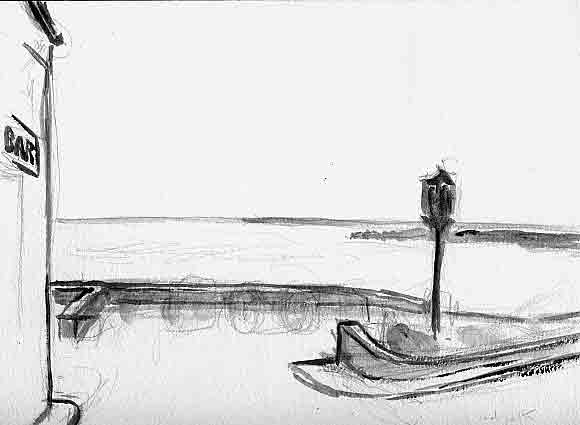|
What you have entered is — a traffic circle. The Cobb Gate traffic circle, or car park.

(Try hovering on this picture. Then if you wonder how I obtained the elevated viewpoint: find out about levitation.)
It is, or should be, an important and beautiful spot. Ahead, just over the stone parapet, the sea breasts the rocks. Left and right open out the views along the coast: to the east a line of noble cliffs, to the west the beach and harbour.
But the small square of ground itself is covered with tarmac. In the middle stands a handsome clock, erected by the town council in 2000 as a war memorial and topped by a spike like a Prussian helmet, to discourage gulls from perching.
Around the clock crawl the cars, typically at least three at a time, hoping for one of the parking spaces against the walls. Who wouldn't want to park here, between the town's midpoint and the sea? — right next to the beach and the ice cream shops? So every car is drawn here; but there are only eighteen spaces, and they are always full. So the cars circle in vain, as slowly as they can (burning maximum fuel) in hope that somebody will move. Often there are three cars circling; sometimes they are all stationary, because one has seen that there is hope of a parked car departing, and is waiting for it to do so; other cars accumulate behind, sometimes up to six or seven, all hovering with engines running. Sometimes the circle of cars develops into a spiral, like an ammonite shell, because the rearmost project out into the street, preventing the foremost from even getting out. Many a car circles four or five times before giving up and seeking one of the parking places a few more steps from the centre. This is not only wasteful and disappointing: it is a bathetic use of the town's focal point.
When Lyme was a real port, this was the actual sea gate, through which goods were brought from the harbour; a busy and dirty place, smelling of fish and thronged with merchants, labourers, horses. Here stood the warehouses, owned by Henry Brook, Lord Cobham, who lived at Colway Manor; also, a market; and, at that time, the Three Cups Inn (noto be confused with the later Three Cups on Broad Street).
Then in 1777, Lyme having become less of a port and already more of a resort, the warehouses were cleared away by Thomas Hollis so that they could be replaced by the Assembly Rooms, where high society gathered for conversation, refreshments, and dancing, as recorded in the letters of Jane Austen.
The place could regain a less ignominious and more imaginative use. Take a short time-trip to what Cobb Gate formerly looked like and what it could in future look like.
But where to go from here? If you are in a car, you must circle back and out the way you came in.
Or, if you've booked a room at the Bay Hotel, to which there is no other wheeled access, you can go gingerly ahead through that narrow corner between the wall on the right and the drop to the beach.
If on foot, you have the same two options as any car, and some more. Leftward, turning the corner of the Cobb Gate Fish Bar, you behold an extraordinary arrangement of artificial scenery, and can walk into it.
And there is yet another direction: seaward. It's a hot day. This bay on England's southwest coast does seem to enjoy more and brighter sunshine than England gets credit for. Ahead, the Cobb Gate Jetty slopes temptingly into the water, and points roughly toward the Cobb. You could, as I do on summer mornings after breakfast on the Bell Cliff terrace above, descend this stone tongue (be careful of its coating of slippery seaweed) and jump in.
|
